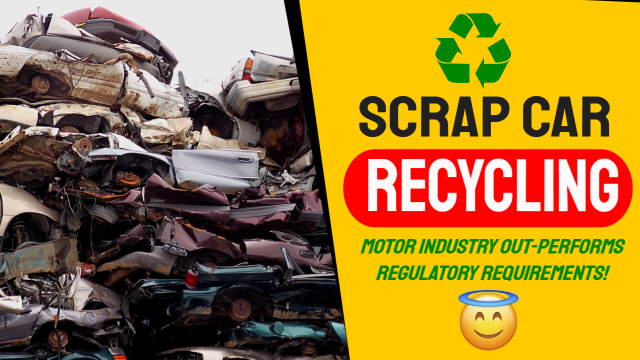In the wake of increasing environmental concerns and sustainable solutions gaining momentum, the motor industry is stepping up its game. Scrap car recycling, a crucial aspect of the automobile lifecycle, has seen transformative changes over the years.
With ambitious targets set by the European Union and noteworthy strides made by countries like the UK, the journey of scrap car recycling has become an emblem of sustainability in action.
Dive into this article to explore the ins and outs of recycling end-of-life vehicles, the impressive advancements made, and the exciting road ahead for the industry:
How does the motor industry meet its ambitious scrap car recycling targets?
Back in 2015, the European Union set an incredibly difficult target for vehicle recycling (also known as scrap car recycling) in the motor industry.
It was decided that with some changes to manufacturing processes and how “end-of-life vehicles” (ELVs) were handled, 95% of the materials used to make a vehicle should be recovered and reused when recycling scrap cars.
With lots of steel and aluminium in scrap cars, recycling rates we already fairly high – with around 85% of materials recovered – but the latest EU figures show that the UK has managed to bump that number up to 96.9%; a figure that beats Germany, France, Norway, and Sweden.
To understand how the UK is leading the way with scrap car recycling, we’ll take a look at the scrap car recycling journey.
A new approach to recycling scrap cars
Although 2015 marked the point at which the UK was expected to reuse/recover 95% of ELV material – the EU’s ELV Directive was actually brought in during Sept 2000, and it represented a staggered approach to reaching this high rate of material recovery.
By 2006, EU states were expected to have reached an 85% recovery rate – and the 15-year overall window was designed to allow new manufacturing processes and materials to complete their life-cycling as a vehicle – before being handled by Europe’s scrap yards.
Higher standards for facilities that recycle scrap cars
In response to the new EU directive, the UK government introduced The End-of-Life Vehicles Regulations in 2003. This wide-spanning piece of legislation introduced the requirement for scrap yards to become registered ‘Authorised Treatment Facilities’ (ATFs).
As well as following a strict set of environmental rules, ATFs would become the only scrap car recycling facilities that could officially destroy an ELV.
To make the destruction process official, the ‘Certificate of Destruction’ (COD) was also introduced – a now essential piece of paperwork issued by the DVLA and sent to the ATF, confirming that the car has been destroyed and is no longer the responsibility of the previous keeper.
This scaffolding that now surrounded the ELV process now meant that cars would not slip through any cracks; every scrap vehicle would be subject to the same official process – handled in a prescribed way by authorised dismantlers.
Recycling scrap cars: the process
Although TV programmes and kid’s cartoons might lead you to believe otherwise, scrap cars do not simply get crushed into a cube and stacked up! In fact, the process is incredibly involved.
This video shows a detailed breakdown of the process – but we’ve summarised it and expanded on some of the steps you’ll see in the video below:
Step 1: Depollution
When your car arrives at the ATF, any hazardous fluids or substances are removed from the vehicle. Generally, this will include:
- Petrol/Diesel
- Engine oil
- Batteries
- Engine coolant
- Brake and transmission fluid
- Windscreen washer fluid
It’s vital that these are removed carefully and handled appropriately. With millions of ELVs processed every year in the UK, there’s the potential for millions of gallons of dangerous fluids to escape and damage the environment if handled recklessly.
Sometimes, these substances will be removed from the site and handled by a specialist company – but it’s not uncommon for ATFs to begin processing these substances on-site. For instance, many ATFs will use specialist storage solutions that allow for ‘reverse osmosis’ – a process that involves passing hazardous fluids over a series of membranes that capture the chemical components and leave clean water.
With fluid removed from the car and handled – the systems that have held these fluids are flushed through, making sure there’s no trace of any impurity before the car moves to the next part of the process.
Step 2: Dismantling
With the car clear of hazardous substances, the dismantling process can begin. Generally, this will involve removing – at the very least – the catalytic converter, the tyres, and the glass from the car.
Tyres can be especially harmful to the environment if they’re not recycled appropriately – so they will be sent to a specialist company that will handle them. Reuse is the name of the game with tyres – and many become soft-floor coverings for sports areas and playgrounds.
The catalytic converter will receive special attention too – not least because the filter inside it contains a host of precious metals that help with the exhaust filtering process. These precious metals can be reused in a host of applications – from medical devices to jewellery.
With these parts removed, the facility will decide whether the car is crushed and shredded – or whether further parts are removed intact and recovered for resale.
Step 3: Destruction and recovery
Until the destruction stage, the vehicle still looks somewhat like a car – but specialist hydraulic presses and industrial shredders will soon change that.
With some or all parts removed from the vehicle, it will then be compressed and fed into a high-powered shredding machine – where even tough steel components will be turned into small chunks, roughly the size of your hand. Since many vehicle parts are coated in tin to prevent rusting, these parts will be ‘detinned’ in a chemical bath to remove this coating – making the materials more easily reused.
The shredded parts from the car are separated again – with most materials generally sold back into manufacturing industries, creating a more circular economy around the motor industry.
Of course, not everything is neatly packaged up and used again – but as technology develops, even the left-over plastics, rubbers, fibres and glass can be reused. These ‘left-over’ materials are referred to as Automotive Shredder Residue (ASR) – and there are specialist companies who can process this material and use it to create synthetic crude oil – slightly easing the strain on the planet’s natural reserves.
Driving recycling forward
They might not look it at a glance, but the dismantlers and yards that recycle scrap cars are actually helping to push the industry forward like never before – and as new manufacturing processes creep through into ELVs, the process will become more and more efficient.
We’re not quite at the stage where 100% of any truly practical car can be reused or recycled – but as more and more manufacturers acknowledge their environmental responsibilities, we’re edging closer to fully sustainable transport all the time.
FAQs on Scrap Car Recycling
What is scrap car recycling?
Scrap car recycling, also known as vehicle recycling, is the process of recovering and reusing materials from “end-of-life vehicles” (ELVs). This approach aims to manage and dispose of vehicles in an environmentally responsible manner, while also recovering valuable materials for reuse.
What was the EU's target for vehicle recycling in 2015?
In 2015, the European Union set a target for the motor industry to recover and reuse 95% of the materials used in manufacturing a vehicle when it reaches its end of life. This ambitious goal was set to promote sustainability and reduce waste in the automobile sector.
How does the UK's scrap car recycling rate compare to other countries?
According to recent EU figures, the UK has achieved a recycling rate of 96.9%, surpassing Germany, France, Norway, and Sweden. This achievement indicates the UK's commitment to leading the way in sustainable scrap car recycling practices.
What changes did the UK make in response to the EU's recycling directive?
The UK government introduced The End-of-Life Vehicles Regulations in 2003. As a result, scrap yards had to register as ‘Authorised Treatment Facilities’ (ATFs). ATFs follow strict environmental guidelines and are the only facilities authorized to officially destroy an ELV. Additionally, a ‘Certificate of Destruction’ (COD) was introduced to ensure every scrapped vehicle follows the same official process.
What is the actual process of recycling scrap cars?
Contrary to popular belief, scrap cars don't just get crushed. The process involves several detailed steps:
- Depollution: Removal of hazardous fluids and substances like petrol, diesel, engine oil, and others.
- Dismantling: Parts like the catalytic converter, tyres, and glass are separated and handled accordingly. Many of these components are repurposed or sold for reuse.
- Destruction and recovery: The remaining vehicle structure is compressed and shredded, with materials like steel being sorted for reuse in manufacturing.
What happens to the leftover materials after recycling?
Not all materials can be cleanly reused. These leftover materials, referred to as Automotive Shredder Residue (ASR), can be processed to create synthetic crude oil, reducing the reliance on natural oil reserves.
Are we close to achieving 100% car recycling?
While significant progress has been made, achieving 100% recycling for practical cars remains a challenge. However, with advancements in manufacturing processes and growing environmental consciousness, the industry is steadily moving towards fully sustainable transport.
Why is scrap car recycling essential for the environment?
Scrap car recycling promotes a more circular economy, reducing the need for new raw materials, and mitigating environmental harm. With millions of ELVs processed annually, proper recycling prevents the release of hazardous materials into the environment and promotes the efficient use of resources.
[Article originally published 3 JUNE 2020. Updated with FAQs added 9 August 2023.]








I had no idea that the metals found in a catalytic converter can be used in medical devices and jewelry. I want to recycle my old car and get money for it. I might take out the catalytic converter first and recycle it by itself for more money.
Here we have a best site which porviding you a best services of recycling the unwanted car removels and to make your car junk-free.
Excellent post! Everyone should read before buying any second-hand car. Keep post this kind of articles and update us. Thanks again, buddy.
Vishal – This is an area for making comments. It is not the appropriate place for you to put advertising, without even the least effort made to say something constructive about the article. I amended your comment.
Thank you very much for scrap car recycling, it’s difficult for me to get such kind of information most of the time always… I really hope I can work on your tips and it works for me too, I am happy to come across your article.
This concept is very good which give us information regarding the scrap car recycling. It is a pleasure worth reading this article. I enjoyed reading this article and would suggest others to come In this particular blog and get all the information regarding it.
One tonne of recycled steel saves 1.5 tonnes of iron ore and half a tonne of coal or fuel. Despite this, I receive as low as $70 for each tonne of steel I recycle. This makes no sense to me. The person selling the raw material should benefit, not the middleman. Consider how much more material would be recycled if it were a bit easier.